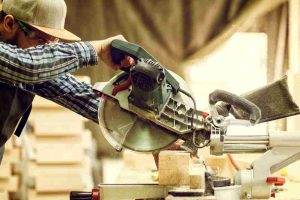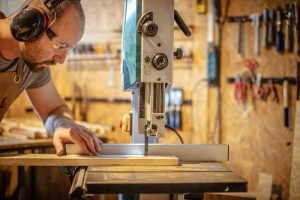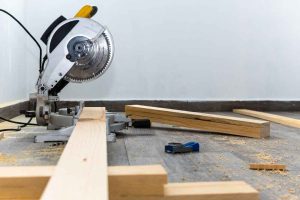A mortise machine is a powerful woodworking tool designed to cut precise square or rectangular holes, known as mortises, into wood. These mortises are essential for creating strong joints and are commonly used in furniture making, cabinetry, and door construction. Unlike traditional chisels or drill presses, a mortise machine ensures clean, accurate, and consistent cuts, improving efficiency and quality in woodworking projects.
Precision is crucial in woodworking, as poorly cut joints can lead to weak structures and misaligned assemblies. A high-quality mortise machine allows woodworkers to achieve flawless joinery, ensuring a stronger and more professional finish. Whether for professional carpenters or DIY enthusiasts, investing in a mortise machine enhances productivity and craftsmanship.
By using the right tools, such as a mortise machine, woodworkers can streamline their workflow, reduce errors, and achieve superior results, making precision an integral part of their craft.
Comparison of Top Models Available at Screwfix
Screwfix offers a range of mortise machines with different power levels, chisel sizes, and adjustability options. A quick comparison of top-rated models can help you decide:
| Feature | Entry-Level Mortiser | Mid-Range Mortiser | Professional Mortiser |
| Power (Wattage) | 370W – 500W | 500W – 750W | 750W+ |
| Chisel Size | ¼” – ⅜” | ¼” – ½” | ¼” – ¾” |
| Table Adjustability | Basic fixed table | Adjustable with clamps | Advanced with X-Y controls |
| Best For | DIY & light projects | Small workshops | Professional joinery |
What is a Mortise Machine?
A mortise machine is a specialized woodworking tool designed to cut square or rectangular holes, known as mortises, into wood. These mortises are used in mortise-and-tenon joints, one of the strongest and most traditional joinery methods in woodworking. The machine helps woodworkers create precise, clean, and consistent cuts, making it an essential tool for furniture makers, carpenters, and cabinet builders.
While other tools like drill presses and routers can create holes and grooves, they are not specifically designed for cutting square or rectangular mortises. Here’s how a mortise machine differs:
- Drill Press – Primarily drills round holes; cannot create square corners without additional chiseling.
- Router – Can create grooves and slots but requires a jig for mortising and doesn’t produce perfectly square corners.
- Mortise Machine – Uses a hollow chisel and auger bit combination to create clean, square-edged mortises efficiently.
Types of Mortising Machines
- Bench Mortisers – Compact, stationary machines ideal for small workshops. They use a hollow chisel and auger bit to create precise mortises.
- Chain Mortisers – Typically used in heavy-duty applications, such as timber framing. These machines use a chainsaw-like mechanism to carve out deep mortises quickly.
- Hollow Chisel Mortisers – The most common type, featuring a drill bit inside a square chisel, which removes material and squares the edges simultaneously.
Each type is suited to different woodworking needs, ensuring efficient and accurate joinery.
Key Features of Mortise Machines at Screwfix
When choosing a mortise machine from Screwfix, it’s important to consider the key features that impact performance, precision, and ease of use. Here are the essential factors to look for:
Power and Motor Capacity
The motor’s power determines how efficiently the machine can cut through hardwood and softwood. Most bench mortisers at Screwfix range between 370W and 750W, providing enough force to create clean, sharp mortises. A higher wattage motor is ideal for heavy-duty woodworking projects.
Chisel Size and Compatibility
Mortise machines use hollow chisels combined with drill bits to create square holes. Different machines support varying chisel sizes, typically ¼-inch to ½-inch, though some high-end models accommodate larger sizes. Ensuring chisel compatibility with your machine allows for greater flexibility in joinery work.
Table Adjustability and Workpiece Handling
A movable, adjustable worktable enhances accuracy and ease of operation. Look for models with:
- Tilting tables for angled mortises.
- Clamping mechanisms to hold workpieces securely.
- X-Y axis adjustments for better positioning.
Depth Stop and Precision Control
A depth stop feature prevents over-drilling, ensuring uniform mortises. Adjustable stops allow for repeatable cuts, which is crucial for consistent tenon-mortise joinery. Precision controls, such as rack and pinion adjustments, further improve accuracy.
Dust Collection System
Woodworking generates a lot of dust, so a dust extraction port is a valuable feature. Machines with built-in dust collection systems help maintain a cleaner workspace, improve visibility, and extend tool life by preventing dust buildup.
By considering these key features, woodworkers can choose a high-quality mortise machine from Screwfix that enhances efficiency and delivers professional-grade results.
Benefits of Using a Mortise Machine
Investing in a mortise machine can significantly improve the quality and efficiency of woodworking projects. Here are the top benefits of using one:
Faster and More Accurate Mortises
Traditional methods like chiseling by hand or using a drill press require extra effort and manual finishing to achieve square mortises. A mortise machine automates the process, cutting clean and precise mortises in seconds. The hollow chisel and auger bit combination ensures sharp edges and consistent dimensions, reducing errors and rework.
Increased Productivity for Woodworking Projects
A dedicated mortising machine speeds up workflow by eliminating the need for additional cutting, measuring, or hand-finishing. This is especially useful for batch production, where multiple mortises of the same size must be cut quickly and accurately. Whether for professional carpenters, furniture makers, or DIY woodworkers, a mortise machine enhances efficiency and project turnaround time.
Professional-Level Finishes
The precision and uniformity of machine-cut mortises result in tighter, stronger joints, essential for high-quality furniture, doors, and cabinets. The smooth, accurate cuts eliminate the need for excessive sanding or adjustments, ensuring clean joinery with a polished, professional look.
By integrating a mortise machine into a woodworking setup, users can achieve superior craftsmanship, improve work speed, and maintain consistency across projects.
How to Choose the Best Mortise Machine on Screwfix
Selecting the right mortise machine is crucial for achieving precision and efficiency in woodworking. Here’s what to consider when purchasing one from Screwfix:
Factors to Consider Before Purchasing
- Budget – Prices for mortise machines vary based on power, features, and brand. Determine how much you’re willing to spend while balancing quality and performance.
- Project Needs – For light-duty projects, a compact bench mortiser will suffice, while professional woodworkers may need a heavy-duty model with greater power and adjustability.
- Brand Reputation – Trusted brands offer better durability, precision, and after-sales support. Look for well-known manufacturers available on Screwfix.
Maintenance and Care for Longevity
Proper maintenance of a mortise machine ensures its longevity, precision, and smooth operation. Follow these essential care tips to keep your machine in top condition.
Regular Cleaning and Lubrication
- Remove wood chips and dust after each use to prevent buildup and clogging.
- Use compressed air or a soft brush to clean the chisel, auger, and machine bed.
- Lubricate moving parts (such as the rack-and-pinion mechanism and chisel holder) with a light machine oil to prevent rust and ensure smooth operation.
- Clean the dust collection port regularly to maintain suction efficiency.
Chisel Sharpening Tips
- Dull chisels affect cutting precision and require more force, leading to potential machine strain.
- Use a chisel sharpening cone to maintain the inner edges of the hollow chisel.
- Sharpen the outside edges with a fine diamond file for a clean, crisp cut.
- Check the auger bit regularly and sharpen it with a drill bit sharpener if needed.
Storage and Handling Best Practices
- Store the machine in a dry, dust-free environment to prevent rust.
- Cover the machine when not in use to protect it from dust and debris.
- Secure chisels and bits in a designated storage box to avoid damage.
- If the machine is portable, transport it carefully to prevent misalignment or motor damage.
Regular maintenance extends the lifespan of your mortise machine, improves performance, and ensures clean, precise mortises for all your woodworking projects.
Frequently Asked Questions (FAQs)
What Materials Can Be Used with a Mortise Machine?
Mortise machines are primarily designed for woodworking, but the type of wood they can handle depends on the machine’s power and chisel strength.
- Softwoods (pine, cedar, fir) are easily mortised with standard chisels.
- Hardwoods (oak, maple, mahogany) require sharper, high-quality chisels and a powerful motor.
- Plywood and MDF can be mortised, but extra care is needed to avoid tear-out.
Using the correct chisel type and sharpness ensures clean, precise cuts in different wood materials.
How Does a Mortise Machine Improve Joinery?
A mortise machine enhances woodworking by creating precise, square mortises, making stronger joints compared to standard drilling or routing methods. Benefits include:
- Perfectly square corners for a tight tenon fit.
- Consistent depth and width, ensuring uniform joinery.
- Stronger joints improve the durability of furniture, doors, and cabinets.
By eliminating inconsistencies and manual errors, a mortise machine results in professional-grade woodworking projects.
Can Beginners Use a Mortise Machine Easily?
Yes! Mortise machines are beginner-friendly, provided users follow the right steps:
- Set up the machine correctly by securing the workpiece and adjusting depth stops.
- Use sharp chisels to reduce effort and ensure clean cuts.
- Practice on scrap wood before working on actual projects.
With a bit of practice, even beginners can achieve precise and professional-looking mortises with ease.
Conclusion
A mortise machine is an essential tool for woodworkers, offering precision, efficiency, and strong joinery for furniture, cabinets, and doors. Unlike drill presses or routers, it creates clean, square mortises quickly and accurately, ensuring professional-quality results. Key features to consider when choosing a machine include power, chisel compatibility, table adjustability, depth control, and dust collection. Regular maintenance, sharpening, and proper storage help extend the machine’s lifespan.
For buyers, DIYers and hobbyists should opt for a compact bench mortiser, while small workshops benefit from mid-range models with adjustable settings. Professional woodworkers should invest in a high-power mortiser with advanced precision controls.
By selecting the right mortise machine at Screwfix, woodworkers can enhance productivity, improve accuracy, and achieve flawless joinery, making it a valuable addition to any workshop.





